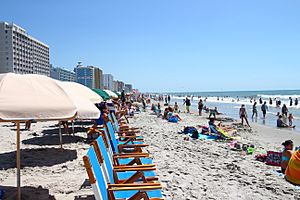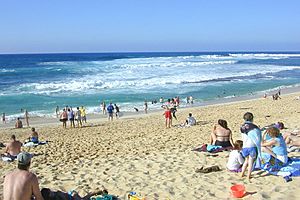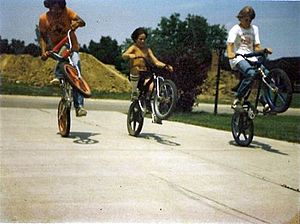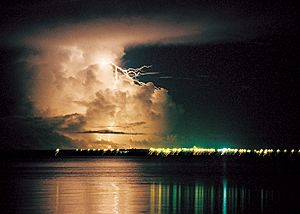Summer facts for kids
Summer is one of the four seasons. It is usually the hottest time of the year. In some places, summer brings the most rain, while in others, it is a dry season. Areas that have four distinct seasons are usually not too hot or too cold all year round.
Summer happens at different times in the northern and southern parts of the Earth. In the northern part of the world, summer is from June to September. In the southern part of the world, it is from December to March. This is because when the northern part of Earth tilts towards the Sun, the southern part tilts away, and vice versa.
Many people travel during summer. They often visit seaside resorts, beaches, camps, or go on picnics.
| Spring | Winter | ||
| The Seasons |
|||
| Summer | Autumn | ||
Contents
When Does Summer Start?

The start of summer can be seen in different ways.
Astronomical Summer
From an astronomy point of view, summer officially begins at the summer solstice. This is the day with the most daylight hours in the year. In the Northern Hemisphere, this is usually around June 20 or 21. In the Southern Hemisphere, it's around December 21 or 22. This way of defining seasons means the solstice is the middle of summer, not the start.
Meteorological Summer
Many weather experts and countries use a different way to define summer. This is called the meteorological definition. It is based on average temperature patterns.
- In the Northern Hemisphere, meteorological summer includes June, July, and August.
- In the Southern Hemisphere, it includes December, January, and February.
This method makes it easier to compare seasons each year because the dates are always the same. It also matches how most people think of summer, as the time with the longest and warmest days. Countries like Australia, Austria, Denmark, and Japan use this definition.
Cultural Summer Dates
Some places have their own traditional dates for summer:
- In Ireland, the traditional Irish Calendar says summer begins on May 1st.
- In the United States, summer is often thought to start around Memorial Day weekend (late May) and end on Labor Day weekend (early September).
- In Canada, summer often starts around Victoria Day (mid-May) and ends on Labour Day.
- In Chinese astronomy, summer begins around May 5th.
- In parts of southern and southeast Asia, summer is the warmest time of year, from March to June, before the monsoon rains begin.
Summer Weather
Summer is usually known for hot or warm weather. In places near the Mediterranean Sea, summer is often dry. But in other areas, especially in East Asia due to the Monsoon, summer is very rainy. This rainy period is when many plants grow a lot, especially in savanna climates.
Storms in Summer
Summer is also a time when certain types of storms happen:
- Tropical Cyclones: These powerful storms (like hurricanes and typhoons) are common in many oceans during summer. In the northern Atlantic Ocean, the season runs from June 1st to November 30th.
- Thunderstorms: In places like the United States and Canada, thunderstorms are frequent from spring through summer. These storms can bring hail, strong winds, and even tornadoes.
Summer Holidays and Breaks
School Summer Breaks

Most schools and universities have a long summer break. This allows students and teachers to enjoy the warmer weather and longer days. The exact dates for these breaks are different around the world:
- In the United States, public schools usually finish in early June.
- In England and Wales, school ends in mid-July and starts again in early September.
- In Scotland and Canada, summer holidays begin in late June and end in mid-to-late August or early September.
- In Russia, the summer holiday starts at the end of May and finishes on August 31st.
- In the Southern Hemisphere, school summer holidays happen during their summer, which includes Christmas and New Year's Day. For example, in Australia, New Zealand, and South Africa, breaks start in early December and end in early February.
- In India, school ends in April and restarts in late June or early July.
Public Holidays in Summer
Many countries celebrate important public holidays during the summer months:
- Independence Day in the United States (July 4th)
- Canada Day (July 1st)
- Bastille Day in France (July 14th)
- Swiss National Day (August 1st)
- Independence Day (Pakistan) in Pakistan (August 14th)
- Independence Day (India) in India (August 15th)
- Australia Day (January 26th)
- Waitangi Day in New Zealand (February 6th)
Popular Summer Activities

With warmer temperatures, people love to spend more time outdoors during summer.
Outdoor Fun and Sports
Common summer activities include:
- Going to the beach
- Having picnics
- Playing sports like association football, basketball, American football, volleyball, skateboarding, baseball, softball, cricket, tennis, and golf.
- Enjoying water sports such as water skiing, wakeboarding, swimming, surfing, tubing, and water polo.
The modern Olympics are usually held during the summer every four years.
Travel and Entertainment
Summer is a very popular time for travel and vacations, especially in countries where schools have long breaks. Many teenagers and college students find summer jobs in places like restaurants, shops, and tourist attractions. This is because businesses related to recreation and tourism are very busy during the summer months.
Also, many television shows for children are released during the summer. This is because more children are at home and have free time to watch TV.
Related pages
Images for kids
-
Fig trees bear fruit when summer is near
See also
 In Spanish: Verano para niños
In Spanish: Verano para niños






